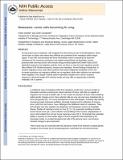Metastasis: tumor cells becoming MENAcing
Author(s)
Gertler, Frank; Condeelis, John
DownloadGertler_Metastasis tumor.pdf (982.4Kb)
PUBLISHER_CC
Publisher with Creative Commons License
Creative Commons Attribution
Terms of use
Metadata
Show full item recordAbstract
During breast cancer metastasis cells emigrate from the primary tumor to the bloodstream, and this carries them to distant sites where they infiltrate and sometimes form metastases within target organs. These cells must penetrate the dense extracellular matrix comprising the basement membrane of the mammary duct/acinus and migrate toward blood and lymphatic vessels, processes that mammary tumor cells execute primarily using epidermal growth factor (EGF)-dependent protrusive and migratory activity. Here, we focus on how the actin regulatory protein Mena affects EGF-elicited movement, invasion and metastasis. Recent findings indicate that, in invasive migratory tumor cells, Mena isoforms that endow heightened sensitivity to EGF and increased protrusive and migratory abilities are upregulated, whereas other isoforms are selectively downregulated. This change in Mena isoform expression enables tumor cells to invade in response to otherwise benign EGF stimulus levels and could offer an opportunity to identify metastatic risk in patients.
Date issued
2010-11Department
Massachusetts Institute of Technology. Department of Biology; Koch Institute for Integrative Cancer Research at MITJournal
Trends in Cell Biology
Publisher
Elsevier
Citation
Gertler, Frank, and John Condeelis. “Metastasis: Tumor Cells Becoming MENAcing.” Trends in Cell Biology 21, no. 2 (February 2011): 81–90.
Version: Author's final manuscript
ISSN
09628924